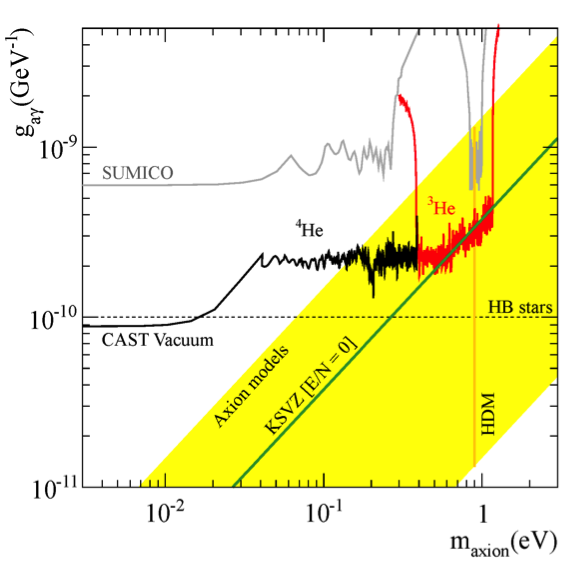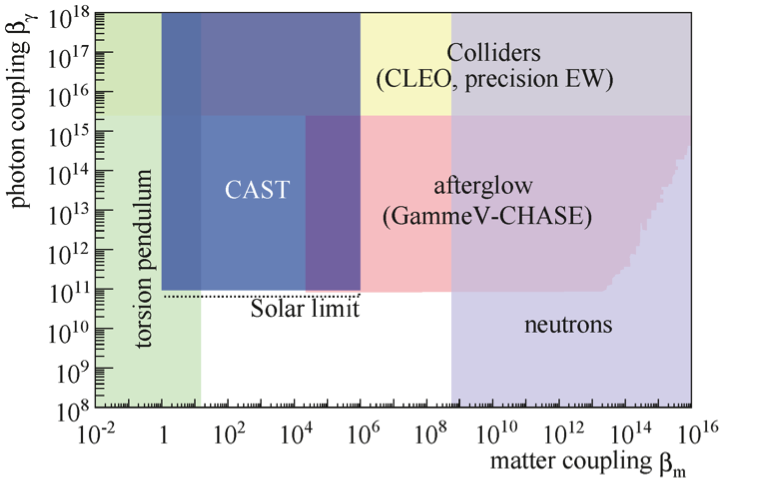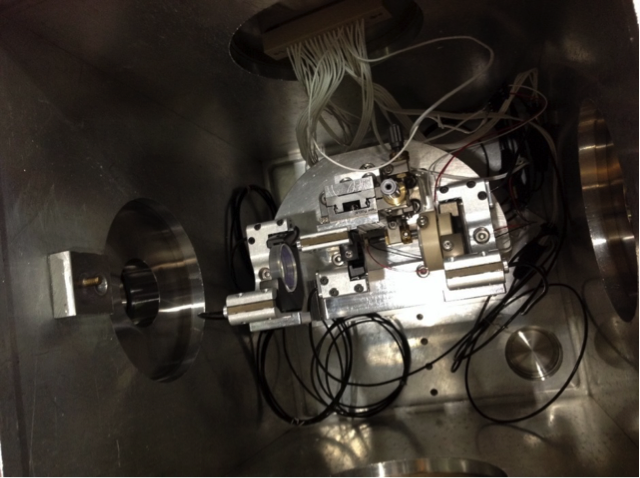CAST in Time – The Quest for Axions and Chameleons
Dark Matter makes up a quarter of the universe and is five times more abundant than normal matter such as neutrons, protons, electrons and neutrinos. Without it, galaxies would fall apart, and stars would spin off into space. Yet we have not identified what dark matter is. An even bigger puzzle remains to the remaining part of the universe: almost three quarters of the energy density of the universe is associated with a mysterious force that drives the accelerating expansion of the universe. At CERN seventeen years ago the CERN Axion Solar Telescope (CAST) set off to unravel these mysteries and to shed some light on the dark.
During the last 14 years the CAST experiment concentrated on the search for QCD-axions, particles introduced by R.D. Peccei and H. Quinn back in the late 70s to overcome the strong CP problem. Although charge conjugation C, parity P, and time reversal T are separately good symmetries of nature in strong interactions, the combination of C and P is not necessarily respected in SU(3)c quantum chromodynamics due to the nonzero QCD vacuum angle. Phenomenology based axion models are controlled by the axion mass ma which in turn is fixed by the scale fa of the Peccei-Quinn symmetry breaking. Theory by itself cannot fix the Peccei-Quinn scale and the axion mass remains an unconstrained parameter on which all axion couplings depend. Very light axions with fa in the range of 1012 GeV, which relates to an axion mass in the range of µeV, might compose some part of cold dark matter (CDM). The exact amount depends on the axion misalignment angle at the time of axion decoupling during the expansion of the early universe. This perception puts the light axion on the top of the list of CDM candidates.

Figure 1: The bounds on solar axion search set by the two helioscope experiments CAST and the SUMICO. The yellow band indicates the theoretically expected relation between the axion-photon coupling constant and the axion mass for different models.
Fascinatingly still today the sun could be a very powerful axion source in next proximity to earth, continuously generating new axions in Primakoff conversions of photons in the strong electric fields of its core. Such axions preserve partly the black body energy spectrum of the photons in the sun due to the high density in the solar core and the very same spectrum is restored in a second Primakoff conversion in the strong electromagnetic field in the laboratory. It is this particular process which plays the key role for the CAST collaboration to identify axions.
CAST exploits the helioscope technique using a decommissioned prototype magnet built for LHC that provides two counter-directed dipole fields up to 9 T each. Here solar axions could be converted back to X-ray photons utilizing the coherent Primakoff mechanism. The magnet is mounted on a movable platform that allows for tracking the Sun during 1.5 hours respectively every morning and evening. It comprises two magnetic bores of 43 mm diameter and 9.26 m length and is equipped with X-ray detectors placed at the bore ends. A unique feature of the CAST experiment are two X-ray telescopes.
The use of the two Wolter type-I X-ray telescopes in axion detection is one of the innovations of CAST. It offers the formidable benefit to measure both signal and background simultaneously with the same detector. Therefore systematic uncertainties caused by variations in photon detection efficiencies in the background subtraction can be reduced considerably. At CAST both telescopes are installed on the Sunrise side of the magnet and focus the magnet aperture by a factor of 150 to a spot of a few millimeters on the photon detector side.
The Photon detectors have been continuously upgraded or exchanged over the past years. The initially installed time projection wire-chamber on the sunset side and the pn-CCD as well as the MicroMegas with strip readout on the sunrise side have been exchanged to state-of-the-art low noise microbulk MicroMegas detectors with analog sampling or InGrid Timepix readout, respectively. The low energy threshold, while reaching an improved suppression of background because of a topological reconstruction of the events, is the advantage of this technology. To this end, following an extensive research program for background reduction and operating the detectors with shielding and in combination with an active veto system very low background levels of up to 10-6 counts/(keVcm2s) have been achieved.

Figure 2: The exclusion region for chameleons depending on the coupling of chameleons to photons vs. their coupling to matter achieved by CAST in 2013 with an SDD detector. Also shown are bounds set by torsion pendulum tests, resonance spectroscopy measurements of quantum states of ultracold neutrons, afterglow and collider experiments.
In the CAST helioscope the signal of axions would have emerged as an excess of counts of the X-rays detectors within the beam spot when the magnet was pointing to the sun and the background remained constant outside of the beam spot. Operating the experiment with either empty bores or filled with 3He or 4He, respectively, at varying densities allowed for scanning different mass regions of the axion phase space. CAST was able to constrain the axion-photon coupling constant from the very low up to the hot dark matter sector. The search range now generously overlaps with the current cosmic hot dark matter bound of ma ≲ 0.9 eV and there would be little benefit in pushing to yet larger masses with the buffer-gas technique as it is shown in Figure 1.
CAST has not seen any axion signal and therefore moved on to transform its magnet to become a haloscope. Recently CAST has been approved to search for relic axions. Such a goal cannot be achieved with the previously used technology and a substantial upgrade program has been initiated. The first choice for the detection of axions with masses in the region of tens of µeV is based on microwave cavities. Dark matter axions entering the region permeated by the strong magnetic field again will be converted to photons. The conversion probability can be significantly enhanced if it occurs in a cavity being resonant to the energy of the mass of the dark matter axion.
During the last couple of years the experiment has widened its horizon. In addition to the different searches for axions CAST has also become a chameleon hunter. Chameleons are scalar particles with the mass scale as a free parameter whereas the natural cosmological choice is falling on 2.4 meV. Some peculiar characteristics let chameleons become the smoking gun to shed new light on the mystery of dark energy: the effective mass of the chameleon is not a constant but its magnitude depends on the local environment. The generation of a density-dependent mass may result from the interplay of two source terms in its equation of motion. The first term arises from self-interactions, the second from the conformal coupling to matter fields. Although the scalar fields can be quite small on Earth their behavior may become drastically different on cosmological scales where the local density is much smaller. CAST is following two complementary directions to trace the imprints left by these mysterious particles.

Figure 3: Bird’s eye view into the vacuum chamber of the KWISP detector. The picture shows the two mirrors on the left and right of the Fabry-Perot resonator and in its center the holding device for the dielectric micro-membrane.
On one hand the InGrid detector and its granular Timepix pad readout, which has a particular low energy threshold of down to 100 eV for photon detection, pioneers searches for solar chameleons. The production and detection mechanisms for chameleons can be quite similar to those for axions but as chameleons would be produced in the Sun’s tachocline instead of its core their energy is much lower, resulting in a wide spectrum peaking at about 600 eV. The signature left by a chameleon coupling to a photon in a Primakoff reaction in the dipole magnet will be identified by its ring shaped signal in the InGrid detector compared to the spot-like form of converted solar axions.
On the other hand the commissioning of a novel force sensor, dubbed KWISP, at the focal plane of the X-ray telescope is aiming to detect solar chameleons or other particles with similar properties via their coupling to matter. The sensor consists of a thin (50 to 100 nm) and rigid dielectric micro-membrane. The membrane is suspended inside a resonant Fabry-Perot cavity. The setup of the KWISP inside the vacuum chamber is displayed in Figure 3. When a laser beam is frequency-locked to the cavity by means of an active electro-optical feedback system, any membrane displacement from the initial position will cause cavity mode frequencies to experience a shift, which is then sensed in the feedback correction signal. The sensor thus transduces a displacement force into an electrical signal and takes advantage of the finesse of the Fabry-Perot resonator which can be as high as 60000. The nominal force sensitivities in the 10-15N range and below have been already reached with the KWISP sensor. Modulating the chameleon flux with a specially devised chameleon chopper will result in another sensitivity gain of an order of magnitude, depending on the structure of the low-frequency noise of the force sensor.
All in all, 14 years after its first data taking the future of CAST is as bright as on the first day and investigating the dark side of the universe, may it be axions or chameleons opens a door to possible surprises which could be waiting around the next corner.
* Corresponding author at: Physikalisches Institut, Albert-Ludwigs Universität, 79104 Freiburg, Germany
E-mail address: Horst.Fischer@cern.ch
